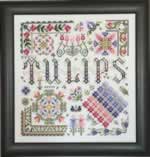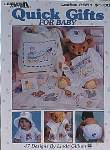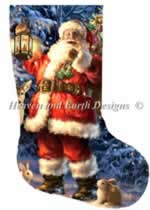|
|
Cross Stitch Helpful Hints
| Starting Cross Stitch | Vol. 1 No. 1 |
You have bought the chart, the fabric to sew it on and the different colored floss, beads, metallic thread, etc. if required, separately, or in a kit - now WHAT DO YOU DO?
1. Iron the fabric so there are no creases. Linens - medium/hot steam iron. Other fabrics - ask supplier.
2. Protect the edges of the fabric from fraying by one of these methods:
a) Machine sew the edges with zigzag stitch
b) Tape all edges, except the selvage, using either masking or scotch tape.
Put a strip on the front and a strip on the back of your fabric
c) Turn in a seam and handset with large stitches around the edge.
3. If you have skeins of floss, you will see numbers on the attached paper labels. These numbers match the numbers on the chart as you will need to know what they are. Buy small cards (plastic and cardboard are available) made especially for winding on the skeins (sometimes called 'bobbins'). At the top, either write, or stick on a label, with the appropriate number. Be very careful to put the right number. The cards can all be kept numerically in a special box.
4. If you have a kit with floss, follow the instructions for organizing the floss carefully.
5. If you wish to wash your floss or fabric, please do it before you sew your cross stitch. If one color runs in the completed project, you will probably never get the discoloration out. Some people wash their skeins in a mild warm soapy water. Then rinse until clear. Dark colors are more likely to run, but good quality threads and fabrics should not.
Note: After completing the project, it might be better to have it
dry cleaned rather than washed, but not if it has beads, or other problem
materials (ask a good quality dry cleaner).
| Starting Cross Stitch | Vol. 1 No. 2 |
1. Keep your work as taut as possible. You will need either a frame or a circular hoop. This will keep your stitches even.
2. If you are using a frame, sew the fabric with large stitches onto the material which runs across the top and bottom bars of the frame, top to top, bottom to bottom.
3. If using a frame, always wind the fabric on the bars so that the BACK is outside. This way the design is covered, and has less chance of being soiled.
4. If you use a hoop, remember to take the fabric off the hoop when finished
each time, otherwise you will make circular marks in it.
| Starting Cross Stitch | Vol. 1 No. 3 |
1. Always have a blunt-ended needle for cross stitch, otherwise you can split the threads of the fabric, or prick another thread or your finger.
2. Tapestry needles, as they are called, are numbered from 18 to 28 in size, but may be had in other sizes. The higher the size number the thinner the needle (the barrel diameter), and the smaller the eye of the needle. They also come in different lengths: small, medium and large.
3. One supplier recommends the following needles for the most commonly
used fabrics:
| Sewing with Cotton Floss | with Kreinik Metallic Threads | |||||
| Aida | Linen Over 2 |
NEEDLE SIZE |
Aida | Mono | Braid | Ribbon |
|
|
6-11 | #32 / #16 | 1/8 | |||
| 6 |
|
11-18 | 14-20 | #16 / #8 | 1/16 | |
| 8-14 | 14-28 |
|
18 | 18-40 | #16 / #8 | 1/16 |
| 16-22 | 30-40 |
|
28-40 | #8 | ||
4. However, make sure that the needle is small enough so as not to make the
holes bigger as you sew each stitch ( by distortion), and not too thin to so as to slip through the holes.
5. Use the size that feels right to you.
5. Although needles used in northern climates are usually nickel plates or stainless steel, they may be had in gold or silver for hot or tropical areas.
6. If you have difficulty in threading a needle, a needle-threader
can be used.
| Starting Cross Stitch | Vol. 1 No. 4 |
1. Before you sew your fabric onto the frame, or put it on a hoop, find the center. You can either:
a) Fold the material in half, first lengthwise, and then sideways to give you the center.
b) Use a tape measure to divide the length and the width into two, and hence measure the center.
c) Measure two adjacent edges with a tape measure and divide by two to find their center threads. Then, using a single strand of floss, sew a running stitch from the edges’ centers, over four to five holes at a time. Where they cross is the center.
d) Or fold the edges as above to find the center threads, and then sew into the center as above.
I mark the center by slipping a spare unthreaded needle under the center
thread.
2. Look at your chart for the center. Most designs have arrows half way down the sides and half way across the top and bottom. If you follow those in with your fingers you will find the center of the design. I normally mark the spot lightly with a pencil.
3. If you do not know how to sew a cross stitch, please go to my 'Useful Links' page and click on the link to about 130
different stitches.
| Starting Cross Stitch | Vol. 1 No. 5 |
The Legend All designs have keys, or legends, usually placed under or at the side of the design. These keys tell you what color to sew where, and if there is an outline, where to place it, and in what color. It will also tell you if the design has beads, specialty threads, etc.
The Floss Having found the center on your chart, look and see what symbol is printed there. The key will tell you what floss number the symbol represents. i.e. Q = DMC 501. Take this card of floss out of your box and cut a length of approximately 36 inches, or from the end of your hand to the tip of your nose. You will now have 6 strands of loose floss. Select one and pull it out, and put the other five back on their card.
The majority of cross stitching is done with two strands, unless the instructions are to the contrary.
Thread your tapestry needle putting together both ends through the eye of the needle so now you have a double strand with a loop at the long end.
If you are right-handed you will probably sew from left to right. It is probably better to sew in rows than in columns, but both are done.
First Row Find the beginning of the row with the color (same symbol) at the center. Count the number of stitches from the center to the start of that row. If you are one or two stitches out at the start, it will not make any difference. Every other stitch is now dependent on this starting stitch position.
Notes:
Evenweave (All linens and similar types usually of counts from 24
to 36) Sew in every other hole. For every stitch on the chart,
double the number, and that is the equivalent number of holes across the
fabric.
Aida Sew in every hole. The number of stitches on the chart represent the number of equivalent holes on the fabric.
Bring your needle up through the correct hole from the back and start cross
stitching.
| Starting Cross Stitch | Vol. 1 No. 6 |
Loose ends sticking out of the back look ragged. Knots make the piece lumpy. Therefore, here are two methods of starting and finishing a row of cross stitches. If you are going to use the same threads a few holes away, there is no need to cut off the ends. Leave it were it is and run it under the few stitches to the next starting point.
When you sew with two strands of the same floss, fold a strand in half, put the two ends through the needle, leaving the loop on the long end. Bring the needle up from the bottom and make the first half cross stitch. Then you go through the loop behind at the end to make a nice firm anchor before you make the second half cross stitch.
With one thread, or two different colors, turn the fabric over and run the floss under five to six stitches next to your first hole for sewing pulling gently until the ends disappear, then come up to do your first cross stitch.
To finish, pass the thread under five to six stitches at the back immediately
next to the last cross stitch, and cut off close to where the thread comes
out.
| Starting Cross Stitch | Vol. 1 No. 7 |
Beads are very pretty and used for many purposes in cross stitch.
For some more information please see the "Glossary".
Listed here are some data about Mill Hill beads as supplied by Gay Bowles Sales.
This information is approximate, and not guaranteed. It is to
be used as a guide only.
| Type | Number Range |
Size | Diameter | Length | Grams/Pack |
Number/Pack Approx. |
||
| Petite | 4xxxx |
15 | 2.0 mm | 8/100" | 1.60 |
500 | ||
| Seed | 00xxx 02000-02031 02033-02092 02093-02095 |
11 | 2.5 mm | 1/10" | 4.54 4.54 4.00, or 2.85 4.54 |
400-500 | ||
| Frosted | 62xxx |
11 | 2.5 mm | 1/10" | 4.25 |
400-500 | ||
| Crayon | 02058-02069 |
11 | 2.5 mm | 1/10" | 4.54 |
400-500 | ||
| Antique | 03xxx |
11 | 2.5 mm | 1/10" | 2.63 |
200 | ||
| Magnifica | 10xxx |
12 |
2.25 mm | 1/11" | 2.00 |
400 |
||
| #8 Seed |
18xxx |
8 |
3.0 mm |
about 1/9" |
6.00 |
250 |
||
| #6 Seed |
16xxx |
6 |
4.0 mm |
about 3/20" |
5.20 |
100 |
||
| Pebble | 05xxx |
3 | 5.5 mm | about 1/5" | 5.50 |
30 | ||
| Bugle | 7xxxx |
small | 2.5 mm | 1/10" | 6 mm | 1/4" | 3.10 |
130 |
| 8xxxx |
medium | 2.5 mm | 1/10" | 9 mm | 3/8" | 2.70 |
70 | |
| 9xxxx |
large | 2.5 mm | 1/10" | 14 mm | 9/16" | 2.95 |
35 | |
| Starting Cross Stitch | Vol. 1 No. 8 |
Beads normally occupy one design space instead of a cross stitch. Most people sew the beads after their surrounding cross stitching is complete because they need to be well secured, and lie on top of the cross stitches . Here are a few pointers:
Thread: For regular and small size beads, use one strand
of floss. For heavier beads you can use two strands. There is
also black or white "Nymo" beading thread, and there is "invisible" YLI thread
which can be used for beading.
Color: Use a color of thread that is close
to the color of the bead, or use a color similar to the background, or one
of the others above.
Needle: Use a fine pointed needle such as a quilting needle,
appliqué needle or beading needle. The hole in most beads is
too small to be used with a tapestry needle.
Stitch: A half cross stitch is normally used, in
the same direction as the lower half of the cross stitch. Since all
your cross stitch projects should normally have all their cross stitches lying
in the same direction, this will make this stitch on top lie in the opposite
direction, but the bead will lie in the same direction as the other top stitches.
Some designs suggest that a full cross stitch is used, but the beads mat
only be attached by the upper cross of each stitch.
Attaching: To start, run the threaded needle for about 3/4 of its
length through the stitches at the back of the design up to the starting hole
of the bead. Come back a couple of stitches and repeat. Bring your
needle up through that hole to the front of the piece. Put the bead
on the needle and come down at the end of the half cross stitch. Now
do a finishing loop similar to your starting loop. If there are several beads,
keep sewing half cross stitches through them until you get to the end of
the row of beads. Then finish with the loop. Some people do the full
cross stitch through the beads to make them more secure. The difference is
the way that the beads will lie. With a full cross stitch the whole
through the bead will lie up and down or sideways depending on which way
you place it. If you use a half cross stitch, it will lie diagonally
either way depending on which way you place it. Make sure you sew them
all the same way. Read any instructions first.
Storing: The packets that beads come in are small
and do not close easily. Find a suitable household container, with
a lid, into which you can dip your needle and pick up a bead. Children and
animals are a great danger to the safety of your beads, and the beads can
be a danger to them.
Precaution: As beads vary slightly in size, they do not
always lie completely flat on the design.
Precaution: Never iron beadwork. The beads will
probably break, or could melt.
Precaution: Some beads are metallic, and are NOT suitable
for jewelry.
For more help try Mill
Hill Tips for Beading
| Starting Cross Stitch | Vol. 1 No. 9 |
Kreinik produce 'braids' that are often used in cross stitch. These
are metallic threads (see 'Glossary'). They are produced in sizes called
#4, #8, #12, #16 and #32, with #4 being the finest (narrowest), and #32 being
the heaviest (thickest).
Braids #4, 8, 12, 16 are usually sewn with one strand. Without other
instructions, they are always sewn with one strand. #4 can be sewn
with one strand of floss as well, then the instructions will say so. Do
not unravel the braid.
Blending filament is mainly sewn with two strands, and is often sewn with
one or two strands of floss as well (hence the term 'Blending'). The
instructions normally state how many strands. Do not unravel the filament.
| Starting Cross Stitch | Vol. 1 No. 10 |
In quick terms, the size of the fabric you want is dependent on the size of the design (the number of stitches across and the number of stitches high that the designs tells you), and the number of stitches per inch you want to sew. You cannot change the design. If you sew "over 2" (linen, etc.), the count of the fabric will be twice the number of stitches per inch. If you sew "over 1" (Aida, etc.), the count of the fabric will be the same as the number of stitches per inch. Use the number of stitches per inch, not the count of the fabric.
To find the size of the design
Divide the number of stitches per inch into the number of stitches across
or high, and you will get the number of inches of the design across or high.
Remember - the fabric has to be bigger for framing and holding, and fraying,
etc.
Design Size for Aida = number of stitches (across or high) / fabric count
(holes per inch = stitches per inch)
Design Size for evenweave = number of stitches (across or
high), / stitches per inch (usually this will be one half of the fabric count,
e.g. if you are stitching on 28ct linen, this number will be 14).
To find the count of the fabric needed
If you want a design to be sewn as a certain size:
Divide the width or the height in inches into the number of stitches that
the design is wide or high, and you will get the count of fabric you need.
Remember - if you calculate the width, the height might come out differently
to what you want. You usually cannot have the height and width as you
want them, as they may not be in the same proportions and the designer laid
down.
Count = number of stitches (wide or high) / width or height wanted.
If the answer is 14, you can use 14 count Aida, or 28 evenweave, and
get the same result.
Example for Linen: If a design is 210 stitches wide by 150
stitches high, and the design is sewn over 2 on 32 count linen, that is 16
stitches per inch:
the linen will have a width of: 210 / (32/2) or 210 / 16 =
13.125" or 13 1/8",
and the height will be 150 / (32/2) or 150 / 16 = 9.375"
or 9 3/8"
Example for Aida: If a design is 210 stitches wide by 150
stitches high, and the design is sewn over 1 on 16 count Aida,
the Aida will have a width of: 210 / (16/1) or 210 / 16 = 13.125"
or 13 1/8"
and the height will be 150 / (16/1) or 150 / 16 = 9.375"
or 9 3/8"
You will see that you need the same size piece of 16 count Aida as you would for a 32 count linen, for the same design.
Changing Fabrics
If you have a design in 32 count that uses 14" by 10 1/2" of linen, you might
want to sew it on 28 count instead. The long way round is to calculate
the number of stitches from the 32 count size and then calculate the 28 count
size from the above formula. It is easier to do this:
Width multiplied by (old count/new count) if sewn over the same number of threads. And the same for the height. Or again, width multiplied by (old stitches per inch / new stitches per inch).
Remember that if 32 count and 16 count require the same size of material,
converting from 32 to 14 count is NOT size x 32/14. Use the number
of stitches per inch.
32 to 14 conversion is normally: width x 16 / 14
Useful Note:
Remember that as the count gets smaller, the finished size gets larger.
So, if you calculate it and the answer gets smaller instead of larger, reverse
your ratio.
If the size on 32 count was 15" by 10 1/2", the size on 28 count will be 16" x 12".
If the size on 32 count was 15" by 10 1/2", the size on 16 count will be the same, and the size on 14 count will be 16" by 12" (the same as the 28 count).
Please note:
1 Not all stitching on linen is done over 2 threads! Check your
instructions first.
2 The above gives the finished size of the design, but you need about
an extra 3" all round for holding, framing, etc. for the fabric cut size,
or you may decide to have a broader boarder. So, if your design size is 11" x 20",
you would need a piece of fabric at least 17" x 26".
3. There are linens from 36 count down to 16 count, so check what the 16
or 18 count material is, Aida or evenweave.
4. Where the word 'linen' has been used above, evenweave may be substituted.
5. If you do not know the size of the design, count the little squares on
the chart. Each one represents a stitch. Also, most charts have
a thicker line every ten stitches, so count in tens across and up, and add
the two or three stitches at each end if any.



